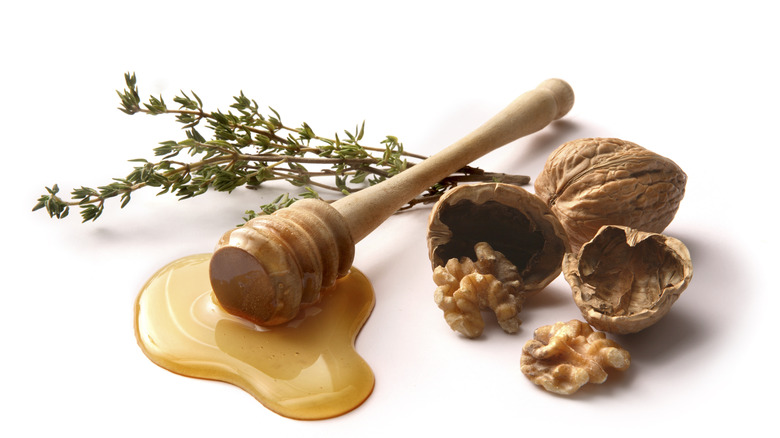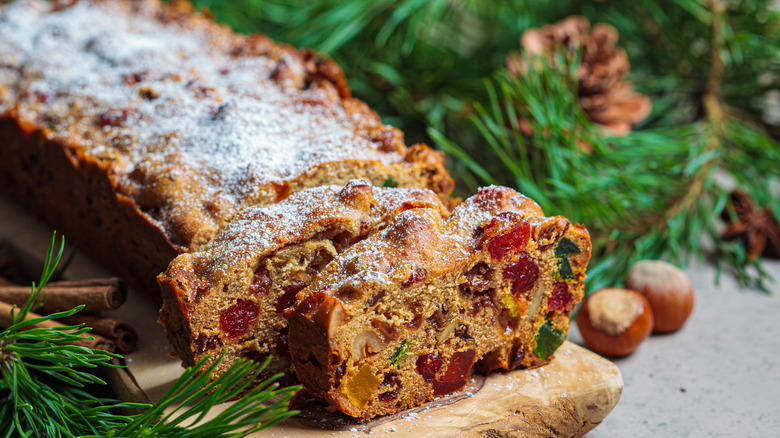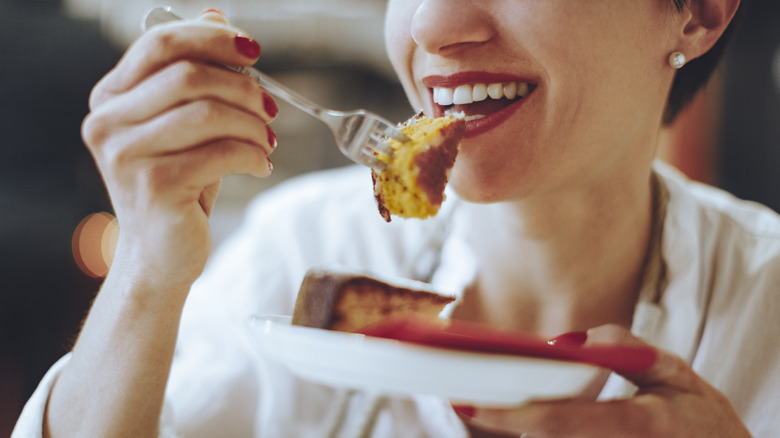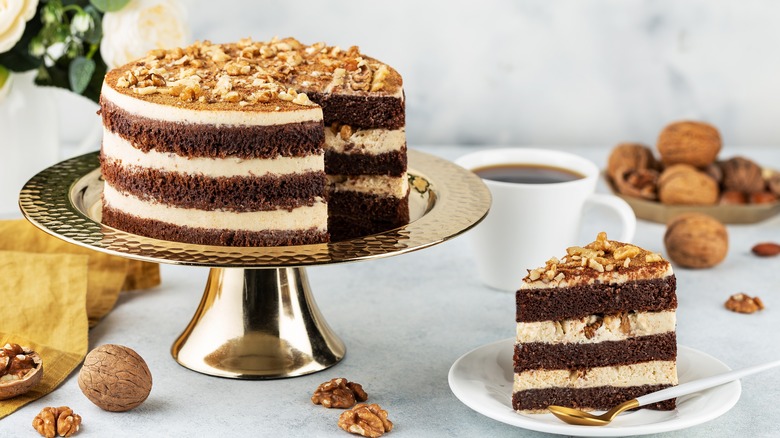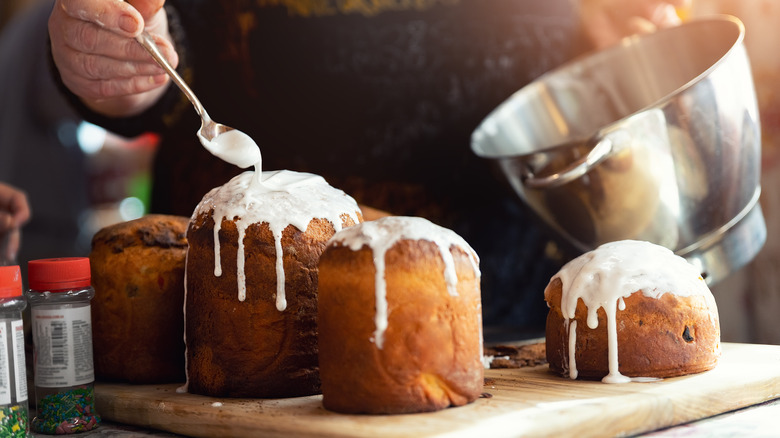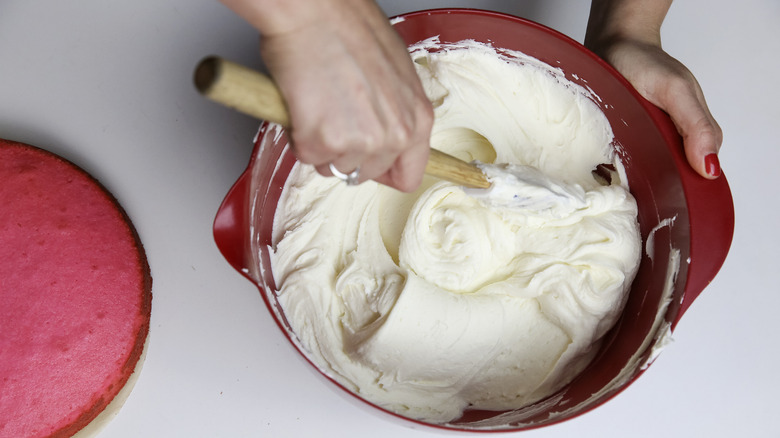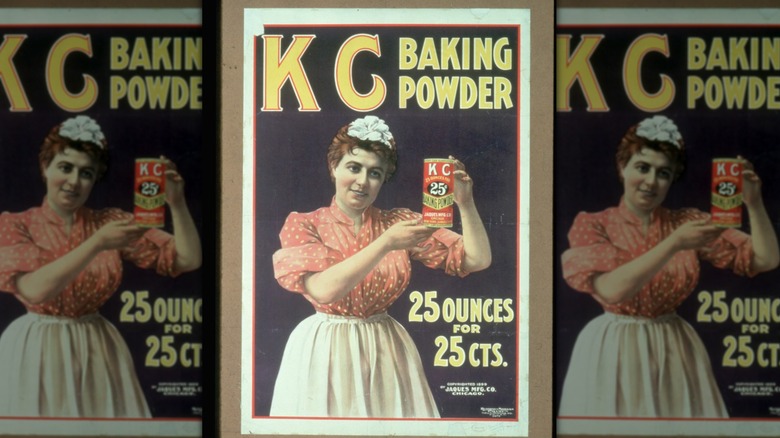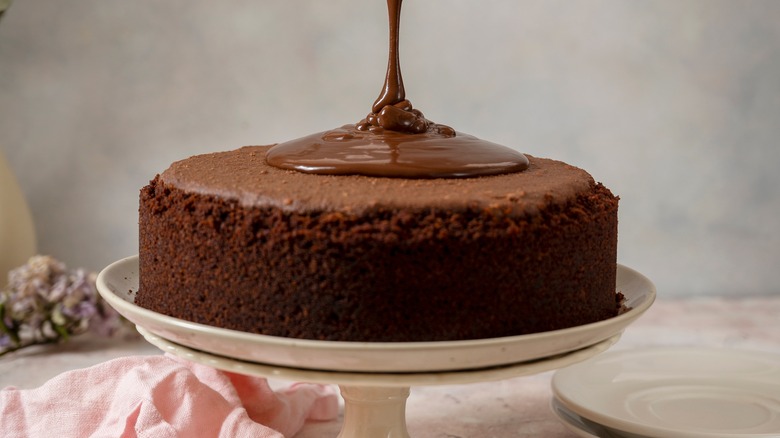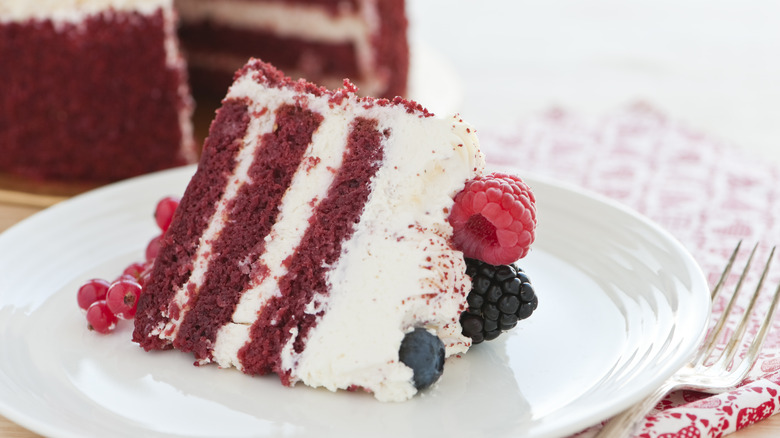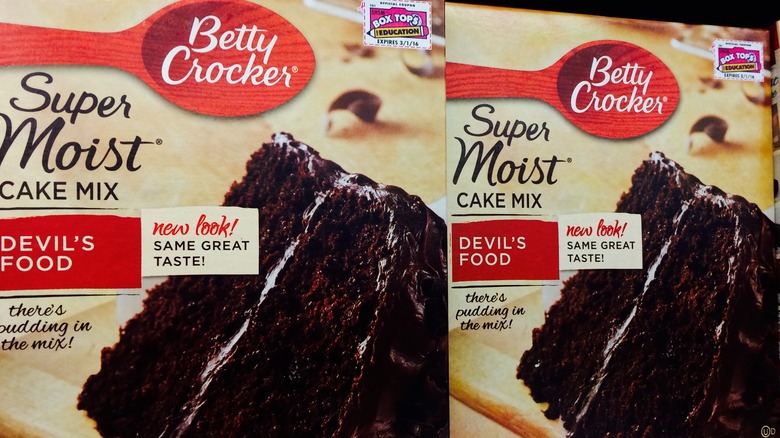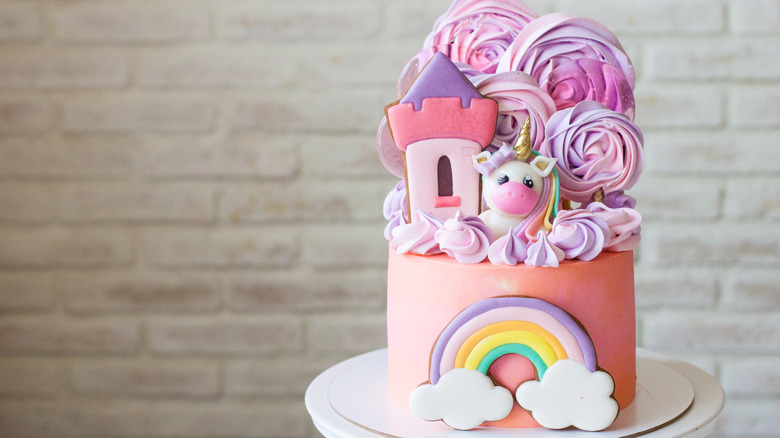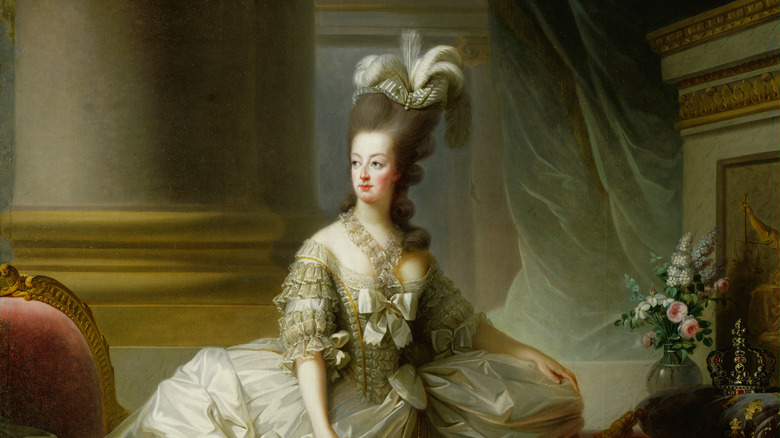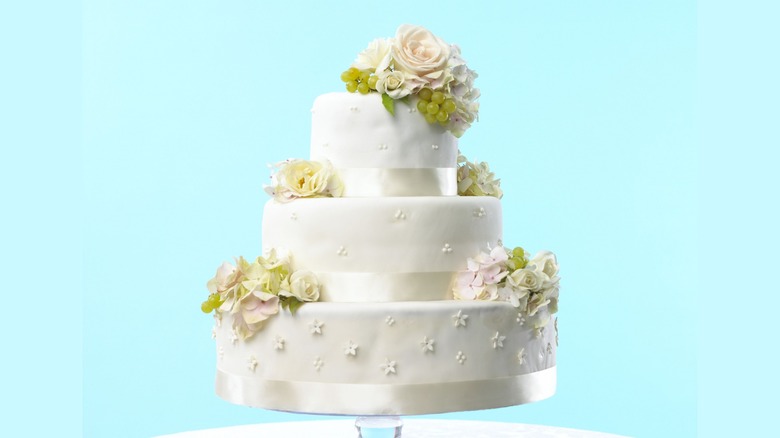The Strange Untold History Of Cake
Cake is undoubtedly one of the most popular desserts found around the world. The history of cake goes back a staggering amount of time – millennia – and has evolved dramatically over time and geographical location. There are so many different kinds that once you dive into this sweet history, you may be left wondering, "What even is cake?" From a historical perspective, a cake can be anything from a sweet yeasted loaf, such as panettone, to a dense fruit cake, to the more common light and fluffy grocery store birthday cake we're familiar with in the United States.
Even within this range, though, there are many varieties, including the genoise, sponge cake, pound cake, and more. The ingredients and techniques may vary, but each one is still a cake. So how did this delicious treat find its way into our lives and nearly every major milestone? We celebrate birthdays, weddings, graduations, pretty much everything with a cake. The strange history and evolution of cake may surprise you.
Cake got its start in ancient Egypt
Cakes exist in some form worldwide and in practically any culture. It is impossible to accurately state who created the first-ever cake and where, exactly, it was made. That being said, some of the earliest forms of cake are thought to have come from ancient Egypt. The ancient Egyptians were some of the earliest bakers and would make grain-based baked desserts sweetened with honey, dried fruits, nuts, and even wine. If this sounds like bread, that is because it functionally was. At the time, the distinction between bread and cake did not exist. While this may be different from modern-day cakes, it set the stage for more to come.
In addition to this, the Romans developed similar bready cakes, which also incorporated nuts and fruits. These early cakes were not the light and luscious cakes we have come to desire so much; they were dense and substantial. Thankfully, baking technology has progressed since then. Both ingredients and cooking implements modernized over time, enabling innovation and variety in cakes.
The Greeks brought us cheesecake
The ancient Egyptians may get to claim the earliest known cake, and the ancient Romans made their own varieties, but they certainly were not the only ones experimenting with sweetened baked desserts. The ancient Greeks had a cake called plakous made from honey and nuts, similar to Egyptian cake, as well as satura, a heavy cake. Both were relatively flat. By 230 CE, the Greeks also gifted the world with the first recorded cheesecake recipe, for which we will be eternally grateful. This cake was called placenta, which is a derivative of the Greek plakous. Eventually, this style of cheesecake spread to Rome, where a similar libum was a cake used for religious practices.
Even into the 1300s, what was considered a cake was really, to many modern Americans, just yeast-leavened bread that included ingredients such as sugar, spices, and butter. These sweet and rich ingredients helped to distinguish it from daily table bread. In medieval Europe, fruit cakes and gingerbread were more common, as they were shelf-stable for much longer than just a simple bread or cake.
The word may be derived from Swedish
As mentioned, there was no distinction between cake and bread for a long time. However, it is important to remember when discussing the terms "cake" and "bread" that those are both English words. Languages naturally adapt and change over time, and it is no wonder that there are a variety of non-English terms for both foods and that, over time, English did develop its own distinction between products.
So where did the word cake come from? Well, from a frankly strange source, the old word "kaka." That's right, a term that today is a homonym for a slang word that means poop. Kaka is still the Swedish word for cake. The first use of kaka in English comes from the 13th century. There could be some relation to the Dutch word koek, which, in addition to evolving into the English word cookie, has the same base as the German word for cake: kuchen. English has always been a mishmash of other languages, taking the odd word or grammar rule and throwing it together with existing usage to make a wholly new one.
Technology advances brought us cake as we know it today
The first major shift from older-style cakes to more modern cakes did not happen until the 1600s. A few important events led to this change. The first is that refined sugar, which probably originated in New Guinea, became more widely available to Europeans. In addition, advances in cooking technology made a huge shift in the shape of cakes.
By the 1600s, ring molds began to be used, which allowed bakers to shape their products with intention. Instead of simply laying slabs of dough on baking trays or crafting unshaped, flat lumps, bakers were able to create tall, round cakes. The first molds used were not like the cake pans many have today. Instead of having an attached bottom, they were just rings made of metal, wood, and paper, which were placed on a baking sheet. Many of the ring molds could be adjusted to change their size, which almost sounds more convenient than what we have today.
Finally, ovens were also slowly changing and making it easier to control the baking conditions. By the end of the 1700s, cast iron stoves with adjustable temperatures made themselves fixtures in home kitchens.
At first, icing was boiled and baked
Of course, what is a cake without some sort of sweet topping? Early cakes may not have had the thick buttercreams we think of today, but they were no less adorned. As early as 1494, marchpane, a thin British cake, is noted as being decorated with almond and sugar paste — similar to marzipan.
While today it is conventional wisdom to hold off on frosting or icing a cake until after it has fully cooled to prevent it from melting into the cake, the first icings were actually meant to do just that. The first recorded use of the verb "ice" (in the sense of icing a cake) comes from the 1600s, while the first description of how to make and use icing came from Rebecca Price in 1655.
Early icings were made of egg whites and sugar, similar to a royal frosting today. The frostings were boiled. Once the cake was cooked, the icing was poured or brushed on the cake, then it was put back in the oven. The result was a fine, shiny, white covering that appeared as ice on the cake. Do you see where we are going with this?
Frostings evolved from ermine to buttercream
The first use of "frosting" comes from 1750. From that early almond paste to hard icing, cake toppings have continued to evolve. By the 1800s, a coating known as ermine frosting became a common choice for cakes. While ermine frosting resembles buttercream, it is instead made of boiled milk, flour, and sugar. This may sound odd, but when it is whipped, it creates a silky and less cloying frosting than buttercream.
Today buttercream frosting is commonly used for cakes. It is hard to say exactly when buttercreams were first invented because there are so many different types. Some buttercream is made from an egg white base, such as Swiss or Italian Meringue buttercream, while French and German buttercreams are made from egg yolks and are more custard-like. Then there is the American buttercream, made of powdered sugar and butter. The American buttercream, which does not require difficult cooking techniques or eggs, is thought to be no younger than the early 1900s.
Textures evolved as baking soda and powder joined the mix
Of course, the last major evolution to bring cakes into the modern world is the evolution of the texture. We know we really didn't sell the early versions of cake, which were dense, flat, and bready, but this is when all that started to change.
The first big change came in the 1500s. Prior to this, the cake was typically a yeasted baked good, which kept it similar to bread – that is until the Italians figured out that by adding whipped egg whites to batter, they could leaven the cakes without the use of yeast. By the 1700s, this had become the go-to method for what we would think of as modern cakes.
However, you may have noticed something missing here. Fear not: science is about to rise to the occasion. Beating egg whites is labor intensive, so people wanted an easier way to leaven cakes. In the 1700s, they began using a product made from lye or ash, known as pearlash or potash, which chemically leavened food. Unfortunately, this unpurified version was smelly and not all that appealing. Luckily by 1846, baking soda hit the scene, and ten years later, baking powder appeared. Both changed the texture of cakes forever, leading to the airy, delicate crumb we know and love.
Chocolate wasn't added to cake until the late 1800s
Chocolate cake is the most popular cake in the world. It is hard to imagine a time when chocolate cake did not exist, but the truth is chocolate cake is a thoroughly modern invention. Chocolate comes from the Aztecs and Mayans, who lived where cacao is a native plant. For them, chocolate was used to make drinks and used for healing purposes.
When chocolate entered the European and white American markets, it was both expensive and took on a life barely resembling its Aztec and Mayan roots. As Stella Park notes in her book "Bravetart," the cost of chocolate products meant that a "chocolate cake" was really just a cake with a chocolate component, such as the chocolate layer cake that features a white cake with chocolate frosting from Good Housekeeping Magazine in 1894. "Chocolate cake" could also include a chocolate ganache. Another term for this at the time was "chocolate paste." Appetizing.
Some recipes from the late 1800s offered versions of paste cake which allowed the cook to either top the cake with chocolate paste or mix it straight into the batter, a revolutionary idea. The earliest record of chocolate-infused cake doesn't show up until 1871. Even at that time, recipes came with two sets of instructions, one where the chocolate was mixed in the cake and one where it was topped. It wasn't until an 1895 "Devil's Food!" that a chocolate-infused cake with no alternate instructions was published.
Red velvet cakes took off after artificial food color hit the market
There has been much uncertainty about the true origins of the red velvet cake. The Waldorf-Astoria in New York City likes to claim credit for its creation, and while they certainly helped to popularize the cake, there is evidence of red velvet before this or its appearance on the Eaton's department store menu.
To trace its true origins, we must look at its name. Back in Victorian times, "velvet" was a term given to soft cakes as a way to promote them. In 1911 an Ohio newspaper published a recipe for velvet cocoa cake, which was a lightly cocoa powdered cake base with boiled milk frosting.
In the South, the cake began to incorporate acidic components such as buttermilk. This acidic component, combined with the cocoa powder, gave the cake a reddish brown hue, notably different from true chocolate cakes such as devil's food. This cake was called "red devil" in 1926; other names include "mahogany cake." Eventually, people wanted a deeper red, and food companies saw a marketing opportunity. Between the 1930s and 1940s, the promotion of the cake skyrocketed as artificial colors and flavors became available. These additions helped elevate some of what was lost due to the rationing of basic baking ingredients such as butter.
Today the boiled frosting is typically replaced with cream cheese frosting, which did not appear until later. Philadelphia Cream Cheese's frosting recipe did not appear until the 1940s.
A surplus of molasses led to the invention of boxed cake mix
The final major change to cakes came with the continued simplification of making them at home. In this case, it was the invention of the boxed cake mix.
The first cake mix was invented in 1933 by Duff and Sons in Pittsburgh, Pennsylvania. Surprisingly, Duff and Sons was a molasses company, not a cake company. Their cake mix was a harkening back to classic cakes such as gingerbread. The inspiration for the creation of this mix was a surplus of molasses during the Depression. The mix had everything in it that was needed for a cake. Just add water!
Duff and Sons expanded from this first mix to offer mixes for bread and muffins, as well as devil's food cake and spice cake. The company was also responsible for the addition of a fresh egg when making the cake at home. Duff and Son's noted that "housewives" preferred fresh eggs to powdered eggs, and they thought it would help sales.
The cake mix really took off after World War II. Large flour companies wanted to sell more products post-war, and the best way to do that wasn't selling plain flour; it was selling mixes. In the late 1940s, Betty Crocker, Pillsbury, General Mills, and Duncan Hines all came out with instant cake mixes, revolutionizing the home baking experience.
Decorated cakes were a marketing ploy to sell boxed cake mix
By the 1950s, sales of cake mix began to slump. To fix this, Pillsbury employed psychologist Ernest Dichter to research and find out how to sell more cakes. Doing his research, he found that the women baking at home felt as though they were taking the easy way out and that they were not putting in enough effort for the cakes. Which was, after all, the whole point of creating a cake mix in the first place.
To counteract this, companies decided to promote cake decorating as a way to make people feel more involved in the process. Of course, cake decorating existed before this, but now box mixes come with instructions for making elaborate cake designs. Suddenly a pretty basic round cake was not enough. Home bakers began attempting to make detailed over-the-top cakes in the shape of castles or even full-on wedding cakes. This, of course, meant the sale of another product: store-bought icing. In order to sell these convenience products, the companies functionally just reallocated the time bakers were spending from mixing cake themselves to decorating.
This set the stage for the American obsession with extreme cakes. Now shows like "Cake Wars" and certain Instagram accounts — showing home bakers creating elaborate and seemingly physics-defying creations — have become the norm, thanks predominantly to clever marketing to sell boxed cake mix.
'Let them eat cake' is incorrectly attributed
Of course, we can't have a history of cake without talking about the most famous quote surrounding our favorite baked good: "Let them eat cake." This quote is famously incorrectly attributed to Marie-Antoinette, queen of France, up until her beheading during the French Revolution in 1793. There was no bread to eat, and Marie-Antoinette supposedly made the statement when asked what her starving subjects should do. Obviously, the quote has been met with derision and is used to show how uncaring and out of touch the royals were. However, we are sorry to inform you that Marie-Antoinette likely did not make this statement.
First of all, the quote in French was actually "Qu'ils mangent de la brioche," which translates as "Let them eat brioche," a kind of bread enriched with butter and eggs. Second, while the quote is most famously attributed to Marie-Antoinette, she is not the only historical person it has been attributed to. There is evidence of a version being attributed to Spanish princess Marie-Thérèse, who married the king of France in 1660. Two other royal women were blamed for the quote during the 1700s. And perhaps most convincingly, a version of the tale shows up in Jean-Jacques Rousseau's "Confessions," written in 1767 — when Marie-Antoinette was 10 years old.
The first wedding cake recipe goes back to 1655
Cake has been used to celebrate special events for thousands of years. It is almost impossible to think of a wedding without picturing a towering, white frosted cake. The cake itself has been a part of wedding rituals for thousands of years, even if the cake does not look as it does today.
The ancient Roman grooms would break a barley cake on the bride's head as a way to mark the marriage. It should be remembered, though, that this "cake" was really more like a sweet piece of bread than a cake today. Still, the ritual bears a passing resemblance to today's cake smash tradition.
When white sugar became more widely available, wedding cakes began to take their modern form. In 1655 the first specific recipe for a wedding cake was published, which was a yeast cake with spices and fruit. Fruit cake is still a common wedding choice for the British royal family. White became the prominent wedding cake color as it was a way to symbolize both wealth of the family and the virginity of the bride. Through the 19th and 20th centuries, wedding cakes became more and more elaborate, thanks in part to British royal influence with their truly massive cakes. Cake toppers began to appear in the 1950s and topped off the modern wedding tradition.
Cake traditions like blowing out the candles are not specific to one place
Perhaps the most common celebratory cake is the birthday cake. When it's time for birthdays, it is time to light up with a party with a cake and some candles. Sweets have been used to celebrate birthdays since the ancient Egyptians. The birthday cake started to take shape with ancient Greeks and Romans, who used bread-like cakes to mark birthdays and weddings. In Greece, we also see the first use of lighted candles on a cake to symbolize the light of the moon and to honor Artemis, the goddess of the moon. However, it was in Pagan tradition that lit candles on a birthday cake started, as the candles were meant to keep evil spirits at bay on a birthday.
The Germans in the 1700s are credited with popularizing the modern form of celebration. German children had cakes lit with candles that symbolized their ages, with one additional candle for another year. Those candles were left to burn all day, and the cake was eaten at night (the celebration was called Kinderfeste). In 1881, Switzerland records show the first blowing out of candles.
What is interesting is that the idea of a birthday cake is not region specific. While the looks of birthday cakes have changed throughout the ages, cake remains a common and tasty way to celebrate birthdays around the world.

